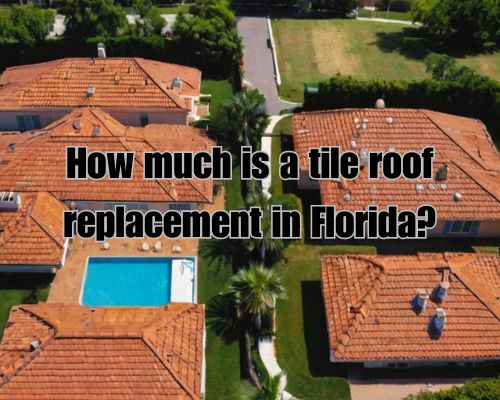How Much is a Tile Roof Replacement in Florida?
Understanding the Costs and Factors
When replacing a tile roof in Florida, many homeowners wonder about the costs involved and what factors can influence the final price. Let us get to know it with Star Roofing West Palm Beach.

A tile roof replacement in Florida typically ranges from $8,674 to $26,169, with an average cost of around $17,011. The wide range in pricing can be attributed to various elements such as the type of tiles used, the total area of the roof, labor costs, and additional features like roof pitch and shape.
Tile roofing is a popular choice in Florida due to its durability and ability to withstand the state’s harsh weather conditions. Concrete, clay, terracotta, and slate are common materials, each offering unique benefits and price points.
For example, the cost per square foot for tile installation can range from $7 to $25, making it essential to understand the specifics of your project before making a decision.
When planning your roof replacement, it’s crucial to consider not only the material costs but also the quality of labor, as this can significantly impact the longevity and performance of your new roof.
Comparing quotes from multiple contractors and verifying their credentials can help you make a well-informed choice, ensuring your investment enhances your home’s value and protection.
Understanding Tile Roof Replacement Costs in Florida
Tile roof replacement costs in Florida can vary widely due to factors like material type, labor, and additional requirements. Key considerations include the type of tile, labor expenses, and other influencing factors such as permits and roof inspections.
Factors Influencing Tile Roof Costs
Multiple elements contribute to the cost of replacing a tile roof.
Location can impact labor expenses, as urban areas may have higher rates.
Roof size also matters; larger roofs require more materials and labor.
Meanwhile, roofing materials like clay, concrete, and slate tiles differ in price. Additional considerations include permits, inspection costs, and potential reinforcement for older structures.
Types of Tile Roofs and Material Costs
Tile roofs come in several types, each with distinct costs.
Clay tiles are durable and can cost between $2 and $14 per square foot. Meanwhile, concrete tiles range from $2.10 to $9.50 per square foot and offer a blend of affordability and durability.
Slate tiles are more expensive, costing up to $25 per square foot. Other options include terracotta, composite, and pantile varieties, each affecting the overall replacement cost.
| Tile Type | Cost per Square Foot |
|---|---|
| Clay Tiles | $2 – $14 |
| Concrete Tiles | $2.10 – $9.50 |
| Slate Tiles | Up to $25 |
| Terracotta Tiles | Varies |
| Composite Tiles | Varies |
| Pantile Tiles | Varies |
Labor Costs for Tile Roof Replacement
Labor costs are a significant portion of the total expense. In Florida, labor rates typically range from $7 to $20 per square foot.
Tile roof installation requires skilled workers, which can drive up prices. It’s also essential to consider costs for permits and any unexpected issues that may arise during the project.
Proper installation ensures the durability of your new roof and minimizes future maintenance. If you are looking for a contractor that has quality work, see Star Roofing West Palm Beach.
Key Considerations Before Replacing Your Tile Roof
Before replacing your tile roof, you need to evaluate the condition of existing structures, choose the appropriate tile style, and understand the installation process involved. This ensures a seamless, efficient transition to a durable, aesthetically pleasing roof.
Evaluating Roof Conditions and Repairs
Begin by assessing the current state of your roof. Look for damaged, cracked, or missing tiles, as these can compromise the roof’s integrity and lead to leaks.
Check for water stains on ceilings or walls, indicating potential water damage.
Hire a structural engineer to evaluate the framework and provide recommendations on necessary repairs. Regular maintenance can extend your roof’s life, but extensive damage may require a full replacement.
Also, consider the roof’s pitch and structure to determine suitable materials and styles.
Selecting the Right Tile Roof Style and Material
Tile roofing offers various styles such as Spanish, Mission/Double Roman, and Mediterranean. Choose a style that complements your home’s aesthetic appeal and structural design.
Tiles can be made from clay, concrete, or hard slate, each with unique pros and cons.
Clay Tiles: Offer longevity and a traditional look but can be expensive.
Concrete Tiles: More cost-effective and long-lasting with a variety of styles.
Hard Slate: Durable and suitable for different climates, though heavy and potentially more expensive.
Consider interlocking styles or flat tiles for better water runoff and durability. Budgeting for both materials and labor is crucial, with costs in Florida averaging $7 to $25 per square foot.
Navigating the Tile Roof Installation Process
Understanding the installation process helps in making informed decisions. Start by removing old tiles and inspecting the underlayment and roof deck.
Proper installation requires skilled professionals equipped to handle the specific materials and styles you’ve chosen.
Ensure the contractor has experience with tile roofing materials and complies with local building codes. Request a detailed estimate and discuss financing options if necessary.
Quality installation can significantly affect the lifespan and effectiveness of your roof, thus hiring certified and reputable roofers is essential.
Regular maintenance post-installation includes cleaning to prevent mold and checking for damage to ensure your tile roof remains long-lasting and efficient.











